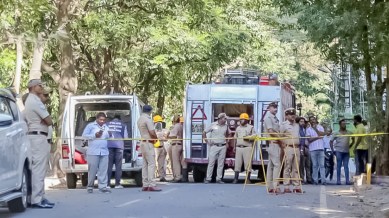Stay updated with the latest - Click here to follow us on Instagram
Son of Indian Mujahideen co-founder under NIA scanner in Bengaluru cafe blast case
Meanwhile, agencies investigating The Rameshwaram Cafe blast are trying to ascertain the identity of the Shivamogga IS module handler

As part of its probe into the March 1 bomb blast at The Rameshwaram Cafe in Bengaluru, the National Investigation Agency (NIA) on Wednesday searched the home of the son of the co-founder of the Indian Mujahideen (IM) who has been on the agency’s wanted list for 12 years.
The action was part of a series of searches at several places in Karnataka and Tamil Nadu by the NIA. Searches were also conducted in Karnataka’s Mandya, Chikamagalur, and Bengaluru with one person from Chikmagalur being summoned by the NIA for further questioning in the case.
monthly limit of free stories.
with an Express account.
The NIA searches were primarily conducted at the homes of the prime suspects in the case Musavir Hussain Shazib and Abdul Matheen Taha as well as their close associate Sardar Naveed. Shazib and Taha are the alleged founding members of an Islamic State module that germinated in the Thirthahalli region of Shivamogga around 2016.
The NIA and other agencies have said they have zeroed down on Shazib, a member of the Shivamogga IS module, as the person who planted the device in the cafe. Shazib along with Taha, an engineer from Shivamogga, are considered the prime suspects in the cafe blast case based on CCTV footage analysis from multiple locations in Karnataka and Chennai. Taha first appeared on the radar of agencies in January 2020 in connection with an IS radicalisation case registered in Bengaluru.
Sources said the searches also involved a visit by NIA officials and others to the home of Abdul Rabiya, 26, the son of Mohammed Iqbal alias Iqbal Shahbandari, in Bhatkal in coastal Karnataka. A high-end mobile phone was reportedly seized by the NIA in the search at Bhatkal. The NIA has called Rabiya for further questioning in the matter, sources said.
Who is Iqbal Shahbandari or Iqbal Bhatkal?
Iqbal Shahbandari or Iqbal Bhatkal, 56, is the older of two brothers from Bhatkal who are considered the founding members of the Indian Mujahideen, a homegrown terror group (with ISI links) that carried out multiple blasts between 2006 and 2013.
Iqbal Shahbandari is believed to have escaped to Pakistan around 2008 when security agencies in India began a major crackdown on the group in the wake of several blasts and the 26/11 attack on Mumbai by the Lashkar-e-Toiba.
Iqbal and Riyaz, also known as the Bhatkal brothers, were considered to have become insignificant after the emergence of the Islamic State as a global terror group to which many youths were attracted after the year 2014 when the IS created a physical caliphate in the Syria and Iraq regions.
In 2012, the NIA registered a grand conspiracy case against the Indian Mujahideen and named 33 people, of whom 14 have been arrested. There is a cash reward of Rs 10 lakh for information regarding Iqbal and Riyaz Bhatkal.
What is the latest on The Rameshwaram Cafe blast?
The agencies investigating The Rameshwaram Cafe blast are trying to ascertain the identity of a handler of the Shivamogga IS module which primarily carried out the explosion. There has been speculation that a missing suspect from some of the older terror cases in the country could be remotely directing the IS module using the pseudonym of “Colonel” during online encrypted chats with key members of the Shivamogga IS module.
The probe in the cafe blast case has revealed that the prime suspect Shazib stayed with an accomplice at facilities in Chennai between the end of January and March 7, 2024.
He allegedly bought a cap and other materials at a clothing store in a mall in Chennai on January 29. CCTV visuals have confirmed the purchase by the suspect and an accomplice. The cap was found in Bengaluru after it was abandoned around three km from the cafe while the suspect fled after planting the IED.
Shazib allegedly travelled to Bengaluru on the evening of February 29 from Chennai – via Tirupati and Nellore – to reach the cafe just before noon on March 1 to plant the Improvised Explosive Device (IED). Investigators are trying to ascertain whether the suspect carried the IED in his bag from Chennai or it was given to him during his journey to the cafe.
In the Mangaluru accidental IED blast case of November 2022, Shivamogga IS module member Mohammed Shariq, 24, assembled the device on his own in Mysuru with easily available materials and carried it to Mangaluru. The IED used in the Bengaluru cafe blast incidentally was made with the same materials and detonation system – except for the container. A pressure cooker was used by Mohammed Shariq in the Mangaluru accidental blast case.
In the IM bombing cases between 2006 and 2013, investigators have found that high-end explosives were sourced and supplied by a separate group while the IED was assembled by bomb experts who usually also planted the devices.